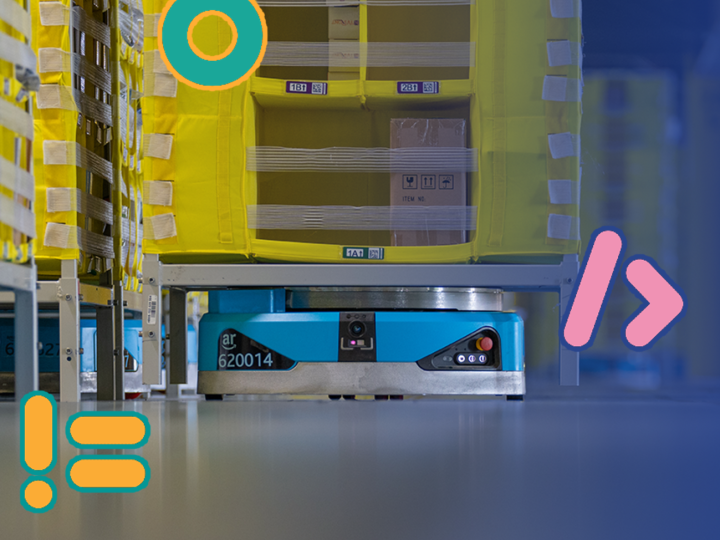K-5 Robotics Fulfillment Center Tour
From our online store to your doorstep, discover how computer science, people, and robotics work together to deliver customer orders at Amazon.
0:00 / 0:00
Video Companion

Students gain exposure to the careers of the future to learn how Amazon’s fulfillment system works and meet the real-life engineers who bring the technology to life.
In this tour, students explore the following careers: hardware engineer, software development engineer, systems/solutions engineer.
In this tour, students explore the following careers: hardware engineer, software development engineer, systems/solutions engineer.

The 45 minute, interactive tour is aligned to Next Generation Science Standards (NGSS) and CSTA K-12 Computer Science Standards. The Teacher Toolkit includes a facilitation guide, worksheets, and other resources to support learning during the tour. Recommended for grades K-5.
The Elementary FC Tour is aligned to the following CSTA standards.
The Elementary FC Tour is aligned to the following CSTA standards.
- 1A-CS-01: Select and operate appropriate software to perform a variety of tasks, and recognize that users have different needs and preferences for the technology they use.
- 1A-CS-02: Use appropriate terminology in identifying and describing the function of common physical components of computing systems (hardware).
- 1A-CS-03: Describe basic hardware and software problems using accurate terminology.
- 1A-DA-05: Store, copy, search, retrieve, modify, and delete information using a computing device and define the information stored as data.
- 1A-AP-08: Model daily processes by creating and following algorithms (sets of step-by-step instructions) to complete tasks.
- 1A-AP-11: Decompose (break down) the steps needed to solve a problem into a precise sequence of instructions.
- 1A-AP-12: Develop plans that describe a program’s sequence of events, goals, and expected outcomes.
- 1A-AP-15: Using correct terminology, describe steps taken and choices made during the iterative process of program development.
- 1A-IC-16: Compare how people live and work before and after the implementation or adoption of new computing technology.
- 1B-CS-01: Describe how internal and external parts of computing devices function to form a system.
- 1B-CS-02: Model how computer hardware and software work together as a system to accomplish tasks.
- 1B-CS-03: Determine potential solutions to solve simple hardware and software problems using common troubleshooting strategies.
- 1B-DA-07: Use data to highlight or propose cause-and effect relationships, predict outcomes, or communicate an idea.
- 1B-AP-11: Decompose (break down) problems into smaller, manageable subproblems to facilitate the program development process.
- 1B-IC-18: Discuss computing technologies that have changed the world, and express how those technologies influence, and are influenced by, cultural practices.
- 1B-AP-15: Test and debug (identify and fix errors) a program or algorithm to ensure it runs as intended.
- K-2-ETS1-1 Engineering Design: Ask questions, make observations, and gather information about a situation people want to change to define a simple problem that can be solved through the development of a new or improved object or tool.
- 3-5-ETS1-1 Engineering Design: Define a simple design problem reflecting a need or a want that includes specified criteria for success and constraints on materials, time, or cost.
- 3-5-ETS1-2 Engineering Design: Generate and compare multiple possible solutions to a problem based on how well each is likely to meet the criteria and constraints of the problem.
- 3-5-ETS1-3 Engineering Design: Plan and carry out fair tests in which variables are controlled and failure points are considered to identify aspects of a model or prototype that can be improved.

Kahoot!: The fun, game-like tour is available for FREE on Kahoot! to all interested classrooms and families. Students can play each other while learning about Amazon’s fulfillment process. No account required.
Teacher Toolkit
Our Teacher Toolkit provides educators with guides, worksheets, and other documents aligned to CSTA K-12 Computer Science Standards and Next Generation Science Standards (NGSS). Use these materials to discover all the possibilities with computer science learning and careers of the future, and to set students up for success before, during, and after the tour.
-
 Student WorksheetDistribute graphic organizers for students to capture their biggest learnings and wonderings on the elementary fulfillment center tour.
Student WorksheetDistribute graphic organizers for students to capture their biggest learnings and wonderings on the elementary fulfillment center tour. Distribute graphic organizers for students to capture their biggest learnings and wonderings on the elementary fulfillment center tour.Distribute graphic organizers for students to capture their biggest learnings and wonderings on the elementary fulfillment center tour.
Distribute graphic organizers for students to capture their biggest learnings and wonderings on the elementary fulfillment center tour.Distribute graphic organizers for students to capture their biggest learnings and wonderings on the elementary fulfillment center tour. -
 Student Worksheet Answer KeyCheck your students fill-in-the-blank answers on the student worksheet.
Student Worksheet Answer KeyCheck your students fill-in-the-blank answers on the student worksheet. Check your students fill-in-the-blank answers on the student worksheet.Check your students fill-in-the-blank answers on the student worksheet.
Check your students fill-in-the-blank answers on the student worksheet.Check your students fill-in-the-blank answers on the student worksheet. -
 Facilitation GuideRead instructions for setting up the Kahoot! tour with classes. Slide by slide script for delivering the tour to students.
Facilitation GuideRead instructions for setting up the Kahoot! tour with classes. Slide by slide script for delivering the tour to students. Read instructions for setting up the Kahoot! tour with classes. Slide by slide script for delivering the tour to students.Read instructions for setting up the Kahoot! tour with classes. Slide by slide script for delivering the tour to students.
Read instructions for setting up the Kahoot! tour with classes. Slide by slide script for delivering the tour to students.Read instructions for setting up the Kahoot! tour with classes. Slide by slide script for delivering the tour to students. -
 Key Student LearningsDiscover the key vocabulary and learnings covered on the elementary tour by tour stop.
Key Student LearningsDiscover the key vocabulary and learnings covered on the elementary tour by tour stop. Discover the key vocabulary and learnings covered on the elementary tour by tour stop.Discover the key vocabulary and learnings covered on the elementary tour by tour stop.
Discover the key vocabulary and learnings covered on the elementary tour by tour stop.Discover the key vocabulary and learnings covered on the elementary tour by tour stop. -
 Student CertificatePrint and distribute student certificates to celebrate completing the tour!
Student CertificatePrint and distribute student certificates to celebrate completing the tour! Print and distribute student certificates to celebrate completing the tour!Print and distribute student certificates to celebrate completing the tour!
Print and distribute student certificates to celebrate completing the tour!Print and distribute student certificates to celebrate completing the tour!
View the Toolkit
FAQs
What will my class see on the tours?
On the K-5 Robotics Fulfillment Center Tour, students will learn what happens behind the scenes from when a customer clicks “order” to the order being delivered. Students learn how hardware, software, and people work together to pick, pack, and ship orders around the globe. At the end of the tour, students meet a hardware engineer, software development engineer, and systems/solutions engineer.
To learn more, check out the teacher toolkit resources.
To learn more, check out the teacher toolkit resources.
What CSTA standards is the tour aligned to?
The K-5 Robotics Fulfillment Center Tour is aligned to the following CSTA standards.
- 1A-CS-01: Select and operate appropriate software to perform a variety of tasks, and recognize that users have different needs and preferences for the technology they use.
- 1A-CS-02: Use appropriate terminology in identifying and describing the function of common physical components of computing systems (hardware).
- 1A-CS-03: Describe basic hardware and software problems using accurate terminology.
- 1A-DA-05: Store, copy, search, retrieve, modify, and delete information using a computing device and define the information stored as data.
- 1A-AP-08: Model daily processes by creating and following algorithms (sets of step-by-step instructions) to complete tasks.
- 1A-AP-11: Decompose (break down) the steps needed to solve a problem into a precise sequence of instructions.
- 1A-AP-12: Develop plans that describe a program’s sequence of events, goals, and expected outcomes.
- 1A-AP-15: Using correct terminology, describe steps taken and choices made during the iterative process of program development.
- 1A-IC-16: Compare how people live and work before and after the implementation or adoption of new computing technology.
- 1B-CS-01: Describe how internal and external parts of computing devices function to form a system.
- 1B-CS-02: Model how computer hardware and software work together as a system to accomplish tasks.
- 1B-CS-03: Determine potential solutions to solve simple hardware and software problems using common troubleshooting strategies.
- 1B-DA-07: Use data to highlight or propose cause-and effect relationships, predict outcomes, or communicate an idea.
- 1B-AP-11: Decompose (break down) problems into smaller, manageable subproblems to facilitate the program development process.
- 1B-IC-18: Discuss computing technologies that have changed the world, and express how those technologies influence, and are influenced by, cultural practices.
- 1B-AP-15: Test and debug (identify and fix errors) a program or algorithm to ensure it runs as intended.
What NGSS Standards is the tour aligned to?
The tour is aligned to the following disciplinary core ideas, crosscutting concepts, and science and engineering practices.
- K-2-ETS1-1 Engineering Design: Ask questions, make observations, and gather information about a situation people want to change to define a simple problem that can be solved through the development of a new or improved object or tool.
- 3-5-ETS1-1 Engineering Design: Define a simple design problem reflecting a need or a want that includes specified criteria for success and constraints on materials, time, or cost.
- 3-5-ETS1-2 Engineering Design: Generate and compare multiple possible solutions to a problem based on how well each is likely to meet the criteria and constraints of the problem.
- 3-5-ETS1-3 Engineering Design: Plan and carry out fair tests in which variables are controlled and failure points are considered to identify aspects of a model or prototype that can be improved.
What STEM topics will be covered on the tour?
The following STEM topics will be introduced and explained in real-life context during the K-5 Robotics FC Tour: algorithms, databases, robotics, sensors, quality control, cloud computing, efficiency, hardware, software, and systems.
How long is the tour?
The tour is designed to take 45 minutes.
What grade levels can attend?
We recommend the tour grades K-5. The tour includes content accessible to each grade and teachers can use the Teacher Toolkit to adjust learning how they see fit.
If you teach a grade above 5th, we have a separate tour for older students.
If you teach a grade above 5th, we have a separate tour for older students.
How much does this cost?
The tour, and all materials included in the accompanying Teacher Toolkit, are provided to teachers at no cost. You do not need a paid Kahoot! account to take the tour - sign up for a free teacher account on Kahoot! or utilize the solo play links on our website to play completely free.
What student data is collected?
We do not collect personal student information on either tour. If a teacher does have a Kahoot! account, they can assign the tour to their students to track their students’ progress, but individuals’ information is not shared with Amazon. During the tour, students will answer poll questions about their intent to persist in careers in STEM and their overall satisfaction with the tour. These questions are multiple choice and do not collect any PII from students.
Can individual students sign up by themselves, independent of a class?
Yes, absolutely. Students can also play the Kahoot! version of the tour on their own.
Why can't I see the videos when I play the tour in Kahoot! ?
We apologize for the inconvenience. Videos are embedded from YouTube, and if blocked by a firewall, will appear as black screens or not play. If your school has YouTube blocked, please have them whitelist the links to each video in the tour.
Who can I contact for questions?
Please reach out to afe-contact@amazon.com for any questions about tour content. For questions about the Kahoot! platform, please reach out to Kahoot!.
Extension Resources
AWS Data Center Tour 1: Uncovering Cloud Computing. Go behind the scenes of “the cloud” to discover how we went from renting movies at the store to streaming from anywhere, at any time.
After taking the tour, teachers can complete a survey to receive a $5 Amazon gift card. (US teachers only)










